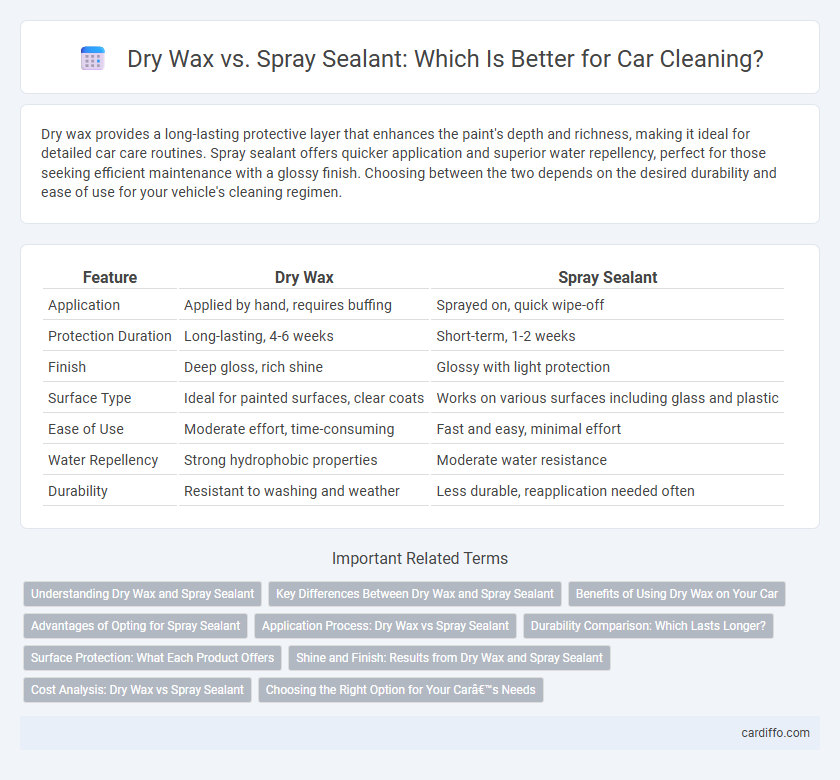Dry wax provides a long-lasting protective layer that enhances the paint's depth and richness, making it ideal for detailed car care routines. Spray sealant offers quicker application and superior water repellency, perfect for those seeking efficient maintenance with a glossy finish. Choosing between the two depends on the desired durability and ease of use for your vehicle's cleaning regimen.
Table of Comparison
| Feature | Dry Wax | Spray Sealant |
|---|---|---|
| Application | Applied by hand, requires buffing | Sprayed on, quick wipe-off |
| Protection Duration | Long-lasting, 4-6 weeks | Short-term, 1-2 weeks |
| Finish | Deep gloss, rich shine | Glossy with light protection |
| Surface Type | Ideal for painted surfaces, clear coats | Works on various surfaces including glass and plastic |
| Ease of Use | Moderate effort, time-consuming | Fast and easy, minimal effort |
| Water Repellency | Strong hydrophobic properties | Moderate water resistance |
| Durability | Resistant to washing and weather | Less durable, reapplication needed often |
Understanding Dry Wax and Spray Sealant
Dry wax provides a durable, protective layer by penetrating the surface and hardening, which enhances long-term shine and water resistance. Spray sealants offer quick application and a glossy finish by forming a lightweight barrier that repels dirt and contaminants. Both products improve surface durability, but dry wax typically lasts longer, whereas spray sealants prioritize ease of use and fast drying times.
Key Differences Between Dry Wax and Spray Sealant
Dry wax provides a thicker, longer-lasting protective layer with enhanced depth and gloss, ideal for older or more weathered surfaces. Spray sealant offers a quicker, easier application and a lighter protective coating, best suited for regular maintenance and preservation of already well-maintained finishes. Key differences include durability, application method, and finish intensity, where dry wax excels in durability and depth, while spray sealant prioritizes convenience and speed.
Benefits of Using Dry Wax on Your Car
Dry wax provides a durable protective layer that enhances the car's paint by repelling water, dirt, and contaminants, ensuring long-lasting shine and protection. Its natural formula allows for deeper penetration into the paint pores, reducing oxidation and minimizing swirl marks for a smooth, polished finish. Applying dry wax also creates a hydrophobic surface that improves water beading and eases future cleaning, making maintenance more efficient and preserving the vehicle's appearance over time.
Advantages of Opting for Spray Sealant
Spray sealants offer a faster application process compared to dry wax, making them ideal for quick cleaning routines and touch-ups. Their lightweight formula provides long-lasting protection against environmental contaminants, enhancing the surface's durability while maintaining a glossy finish. Additionally, spray sealants are easy to apply on various surfaces, ensuring even coverage and reducing the risk of streaking or buildup.
Application Process: Dry Wax vs Spray Sealant
Dry wax requires thorough surface preparation and is applied by hand or buffer, allowing for better control but demanding more time and effort. Spray sealant offers a quick, easy application by misting over the surface and wiping off with a microfiber cloth, ideal for faster maintenance and less labor. Both methods protect paint, but the choice depends on desired durability and convenience in the cleaning process.
Durability Comparison: Which Lasts Longer?
Dry wax typically offers a more durable protection layer on surfaces, lasting up to several months depending on conditions, while spray sealants usually need reapplication every 4-6 weeks due to their thinner, less resilient coating. The molecular structure of dry wax creates a harder barrier against contaminants and UV rays, enhancing long-term surface protection. Spray sealants provide a quick shine but sacrifice longevity, making dry wax the preferred option for extended durability in cleaning and maintenance.
Surface Protection: What Each Product Offers
Dry wax forms a durable, long-lasting barrier that effectively repels water, dirt, and UV rays, preserving the surface's finish for months. Spray sealants provide a quick, easy-to-apply protective coat that enhances gloss and offers moderate resistance against contaminants and environmental damage. While dry wax excels in deep surface protection and longevity, spray sealants are ideal for frequent maintenance and enhancing surface shine between wax applications.
Shine and Finish: Results from Dry Wax and Spray Sealant
Dry wax delivers a deep, rich shine with a natural, hand-applied finish that often lasts longer on the paint surface. Spray sealants provide a glossy, reflective finish with enhanced hydrophobic properties, offering quick application and improved water beading. Both products protect the surface, but dry wax excels in depth and warmth of shine, while spray sealants prioritize convenience and high-gloss durability.
Cost Analysis: Dry Wax vs Spray Sealant
Dry wax generally incurs higher upfront costs due to the time-intensive application process and the need for multiple coats to achieve durability. Spray sealants offer a more cost-effective solution with quicker application times and reduced labor expenses, making them ideal for frequent use and maintenance. Over time, spray sealants can lower total costs by minimizing the need for repeated waxing and extensive surface preparation.
Choosing the Right Option for Your Car’s Needs
Dry wax offers a durable, high-gloss finish ideal for classic cars and those seeking long-lasting paint protection, while spray sealants provide quick application and enhance water repellency with synthetic polymers. Evaluating factors such as desired shine, frequency of application, and environmental exposure helps determine the optimal choice for maintaining your car's exterior. Selecting the right product improves paint preservation and ensures your vehicle stays protected against dirt, UV rays, and contaminants.
Dry wax vs Spray sealant Infographic

 cardiffo.com
cardiffo.com